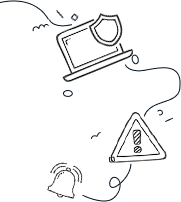Introduction
Despite the leaps and bounds we’ve made in cybersecurity, the human element remains the most vulnerable link in the security chain. In fact, 95% of cyberattacks start with a human making a mistake. Sounds like a classic case of “oops” if you ask me!
People have emotional weaknesses that threat actors like to exploit. These social engineering attacks are the cyber equivalent of a magician pulling a rabbit out of a hat—except instead of a rabbit, it’s your confidential information! So, what do you know about this dangerously captivating cyber-threat, and how can you keep your data safe without needing a magic wand?
How Social Engineering Works
The primary goal of these attacks is to scoop up your private credentials like a kid in a candy store. Once the attackers have your login information, they can infiltrate systems in under a minute—and trust me, that’s faster than my morning coffee kicks in!
Social engineering surged by a staggering 442% in just the second half of 2024. Attackers love to manipulate your natural instincts—like trust, fear, and curiosity—like a cat with a laser pointer. They slip past your firewalls and antivirus software faster than you can say “phishing scam” because they prey on that split-second thoughtlessness we all have when we’re distracted.
The rapid exploitation leaves precious little time for detection, let alone a good cup of coffee to think things through—so let’s keep our wits about us!
Why Social Engineering Is So Effective
To make their cyberattacks as successful as a cat video going viral, social engineering threat actors craft their messages to be so personalized that it feels like they’ve been stalking your Instagram account. What makes these threats particularly hair-raising is their ability to evolve faster than a superhero in a sequel. As organizations invest in rock-solid technical defenses, attackers turn their focus to the squishy, unpredictable part of the equation: people. And with the help of AI, these attacks are getting more believable than ever—imagine your grandmother suddenly becoming a tech expert!
Seriously! AI tools can analyze mountains of personal data from social media, public records, and corporate websites. They provide attackers with the power to craft messages that feel eerily personal, mentioning that weekend picnic or your favorite coffee shop’s new limited edition latte. If you get an email talking about how fun the office karaoke night was, you might just fall for it—as if you weren’t still trying to recover from last year’s disastrous rendition of “Sweet Caroline.”
How Can You Protect Yourself from Social Engineering?
Social engineering preys on your emotions, nudging you to share sensitive information you’d otherwise guard like a dragon with its treasure. If someone’s pressuring you, that’s your cue to step back—and possibly call in backup. No one wants to be the hero in a horror movie!
Your annual Security Awareness Training is the trusty sword at your side in the battle against cyber threats. Pay attention to those training courses; you’ll want the most up-to-date intel on how to fend off the cyber dragons lurking in the shadows.
Meanwhile, cybersecurity threats can change faster than fashion trends. Just because threat actors prefer ransomware through text messages in January doesn’t mean they won’t concoct a new form of phishing by December (or decide to dress up as a popular meme). Keeping refreshed with regular video updates and headlines ensures you keep your cyber-hygiene top-of-mind, just like you remember to floss (or at least, we hope you do!).
The post How Social Engineering Is Evolving in 2025 appeared first on Cybersafe.




